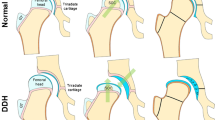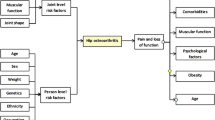Abstract
Purpose
Acetabular orientation is important to consider in hip joint pathology and treatment. This study aims to describe the functional orientation of the acetabulum as a representative measure of force transmitted through the hip joint generated from bone density mapping and compare it to landmark-based anatomical orientation measures.
Methods
CT scans of 38 non-pathologic individuals were analyzed. Functional orientation was computed as the density-weighted average of the acetabular surface normals based on surface density maps. Two anatomical measures were also used to describe the orientation of each acetabulum: the normal to the acetabular rim plane and the abduction angle based on AP pelvic “Radiographs” generated from the CT data.
Results
The average functional and anatomic abduction and anteversion angles ranged from 32°–58° and 22°–31°, respectively, with significant side-to-side correlation in individual patients for the majority of measures. Functional acetabular orientation was weakly correlated only with the rim plane measure. Native acetabular abduction in the 3D anatomic and functional methods was significantly shallower than the 2D “Radiographic” measure. The vector generated to describe functional acetabular orientation was found to be more vertically and posteriorly oriented than the anatomic measures.
Conclusions
Functional acetabular orientation, reflecting the calculated directionality of the subchondral bone density, yields a more posterior and vertical measure of acetabular orientation as compared to the direction of load transmission suggested by the anatomic methods.
Similar content being viewed by others
References
Murray D (1993) The definition and measurement of acetabular orientation. J Bone Joint Surg Br 75: 228–232
Maruyama M, Feinberg JR, Capello WN, D’Antonio JA (2001) Morphologic features of the acetabulum and femur - Anteversion angle and implant positioning. Clin Orthop 393: 52–65
Nagao Y, Aoki H, Ishii SJ, Masuda T, Beppu M (2008) Radiographic method to measure the inclination angle of the acetabulum. J Orthop Sci 13: 62–71
Stem ES, O’Connor MI, Kransdorf MJ, Crook J (2006) Computed tomography analysis of acetabular anteversion and abduction. Skeletal Radiol 35: 385–389
Tallroth K, Lepisto J (2006) Computed tomography measurement of acetabular dimensions: normal values for correction of dysplasia. Acta Orthop 77: 598–602
Dalstra M, Huiskes R (1995) Load transfer across the pelvic bone. J Biomech 28: 715–724
Harada Y, Wevers HW, Cooke TD (1988) Distribution of bone strength in the proximal tibia. J Arthroplast 3: 167–175
Johnston JD, Masri BA, Wilson DR (2009) Computed tomography topographic mapping of subchondral density (CT-TOMASD) in osteoarthritic and normal knees: methodological development and preliminary findings. Osteoarthritis Cartilage 17: 1319–1326
Turner CH (1992) Functional determinants of bone structure: beyond Wolff’s law of bone transformation. Bone 13: 403–409
Lubovsky O, Peleg E, Joskowicz L, Liebergall M, Khoury A (2010) Acetabular orientation variability and symmetry based on CT scans of adults. Int J Comput Assist Radiol Surg 5: 449–454
Lubovsky O, Wright D, Hardisty M, Kiss A, Kreder HJ, Whyne C (2011) Importance of the dome and posterior wall as evidenced by bone density mapping in the acetabulum. Clin Biomech 26(3): 262–266
Hardisty M, Gordon L, Agarwal P, Skrinskas T, Whyne C (2007) Quantitative characterization of metastatic disease in the spine. Part I. Semiautomated segmentation using atlas-based deformable registration and the level set method. Med Phys 34(8): 3127–3134
Wright D, Whyne C, Hardisty M, Kreder HJ, Lubovsky O (2011) Functional and anatomic orientation of the femoral head. Clin Orthop Relat Res (Epub ahead of print)
Buckland-Wright JC, Lynch JA, Macfarlane DG (1996) Fractal signature analysis measures cancellous bone organisation in macroradiographs of patients with knee osteoarthritis. Ann Rheum Dis 55: 749–755
Bombelli R, Santore RF, Poss R (1984) Mechanics of the normal and osteoarthritic hip. A new perspective. Clin Orthop Relat Res 182: 69–78
Carter DR (1984) Mechanical loading histories and cortical bone remodeling. Calcif Tissue Int 36: S19–S24
Cowin SC (1986) Wolff’s law of trabecular architecture at remodeling equilibrium. J Biomech Eng 108: 83–88
Bergmann G, Graichen F, Rohlmann A (1993) Hip joint loading during walking and running, measured in two patients. J Biomech 26: 969–990
Bergmann G, Deuretzbacher G, Heller M, Graichen F, Rohlmann A, Strauss J, Duda GN (2001) Hip contact forces and gait patterns from routine activities. J Biomech 34: 859–871
Afoke NY, Byers PD, Hutton WC (1987) Contact pressures in the human hip joint. J Bone Joint Surg Br 69: 536–541
Bay BK, Hamel AJ, Olson SA, Sharkey NA (1997) Statically equivalent load and support conditions produce different hip joint contact pressures and periacetabular strains. J Biomech 30: 193–196
von Eisenhart-Rothe R, Eckstein F, Muller-Gerbl M, Landgraf J, Rock C, Putz R (1997) Direct comparison of contact areas, contact stress and subchondral mineralization in human hip joint specimens. Anat Embryol 195: 279–288
Adams D, Swanson SA (1985) Direct measurement of local pressures in the cadaveric human hip joint during simulated level walking. Ann Rheum Dis 44: 658–666
Sadeghi H, Allard P, Prince F, Labelle H (2000) Symmetry and limb dominance in able-bodied gait: a review. Gait Posture 12: 34–45
Muller-Gerbl M, Putz R, Kern R, Kierse R (1993) People in different age groups show different hip-joint morphology. Clin Biomech 8: 66–72
van Bosse HJ, Lee D, Henderson ER, Sala DA, Feldman DS (2011) Pelvic positioning creates error in CT acetabular measurements. Clin Orthop Relat Res 469(6): 1683–1691
Author information
Authors and Affiliations
Corresponding author
Rights and permissions
About this article
Cite this article
Lubovsky, O., Wright, D., Hardisty, M. et al. Acetabular orientation: anatomical and functional measurement. Int J CARS 7, 233–240 (2012). https://doi.org/10.1007/s11548-011-0648-3
Received:
Accepted:
Published:
Issue Date:
DOI: https://doi.org/10.1007/s11548-011-0648-3




